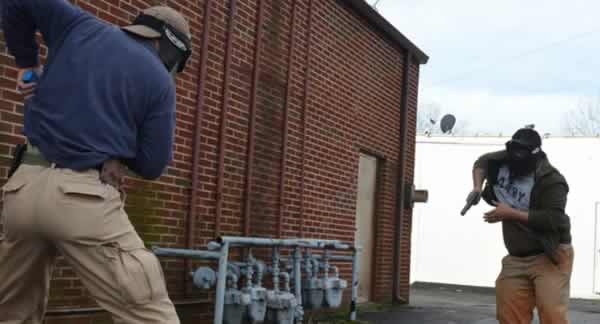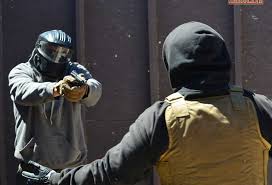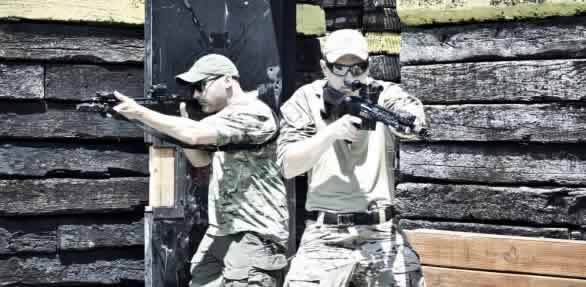
Close Quarter Handgun Training
There’s more to it than Bang Bang.
With your favorite handgun Glock or Sig consider practice shooting as if how you would actually shoot in a real life threatening situation, which will help better prepare you for survival. However the problem is we can’t just be shooting at each other with live rounds, this can warrant casualty and against the law.

So the idea is to replicate the skills in context that would happen in real life. We will break this down into two different ways to train, first is with force on force and second is live fire training.
In most systems of martial arts, the practice of sparring is a common ritual. Firearms form of sparring would be doing “force on force” training. A sound force on force training will help increase your awareness and know your physical limitations.

Force on Force Training
For close quarter shooting purpose these drills isn’t meant to be like a mini war game. For self defense, utilize real life scenarios of what if’s. The drill will only last for 5 to 10 seconds, we are focusing on the initial response. Knowing the objective of the drill is vital to improving your skill. Here’s a sample:
- Drill 1 – Face off against your partner from 10 feet away, on the command of go – both partners will draw and shoot multiple rounds.
- Drill 2 – Starting from the ground position (on your back) both parties are 10-15 feet apart, nearby are barricades (can be furniture or office equipment) – on the command go – both will engage at each other.
- Drill 3 – This one takes it up a notch combining a little “Mixed Martial Arts” with pistolcraft – both are armed and holstered.
One thing to understand about this drill is that the drill starts after “contact” is made between the two. (perp & victim)
So forget the “I’ll just pull my gun out and shoot his $ss” mentality. This scenario can be like someone coming up to you and asking for the time. You’re now at arm to 6 feet away to the perp.
There are many variable, typically The drill can have one on the bottom the other on top (in the mount) – on the command of go you both try to draw your handgun and shoot off multiple rounds.
Or maybe the victim is on the bottom with a pistol, perp on top armed with a knife. – The video below from “ShivWorks” conducting one of their ECQC (Exteme Close Quarter Concepts) course highlights the action.
Force on Force Thoughts and Feedback Assess
You’ll find when you’re up against someone else that your natural instinct is self-preservation. The first response vary from person to person, they can be stationary or mobile right off the bat. The movements are based off of your natural physical ability. If you find that you’re just not moving well to the right as you draw or during the shoot, or getting up from the ground position while leaning on your gun arm. (that’s a no no). Work on building up those skills with repetitive motions and continue to work the basic scenario (above drills). So basically its not only tactics but on explosive initial movements when you do these types of force on force drills.

Live Firing
This is where we apply real application to handgun training. Instead of having a conventional pistol course of fire, this course is tailored to shooting in self-defense mode. But, we’re distilling it further to its primal stage. That is shooting at high speed while on the move within 10 yards.
Regular course of fire is fine for basic marksmanship, but for close quarter shooting is a different story. The course of fire must evolve to the self defense level. When we go through a normal course of fire from looking at paper targets to shooting the different combo patterns to tactical reloads. The shooter is still in a stationary position. What we learn from force on force training when a live subject is coming after you, your response and shooting is totally different than what was learned in basic course of fire structure, just going through the motions.
Bear in mind the following suggestions for training is not about improving your marksmanship. It is about fighting with your firearm, throw out sight alignment instead concentrate on “target acquisition and point shooting” while in motion. Next assess yourself on how you move (responded) initially from the force on force drills. For example if you were the rabbit type that moved and drew your gun, then apply those behaviors into the course of fire. Here’s the setup for the following drills, be sure to have a steel or paper silhouette target available, steel preferred for instance feedback – Here’s the drills:
- Drill 1 – Target at 5 yards draw and shoot (multiple shots) while moving either to the left or right. Progress this to a moving target, at the command go you move left or right and target may move to the left or right as well.(control by a trainer)
- Drill 2 – Target at 15 yards at the command “go” rush over to the right or left diagonally to a barricade- while on the move you must have gun drawn and fire off multiple shots at target.
- Drill 3 – Shooting from a barricade at target from 10 yards – idea here is just to do a quick peek with a couple of shots fire in under a second
Just a note, going through close quarter shooting this way is about instilling this form of reflexes when it comes to gun fighting. This isn’t the real thing, but close to it and the more you train the better you get, but don’t forget basic marksmanship is the foundation. So yes, target practice has its block for maintenance and testing hardware, we’re not dissing (is this an actual word?) it.
Tell us about your experiences with Tactical gun schools.





